Movies We Like
Handpicked By The Amoeba Staff
Films selected and reviewed by discerning movie buffs, television junkies, and documentary diehards (a.k.a. our staff).
Schindler's List
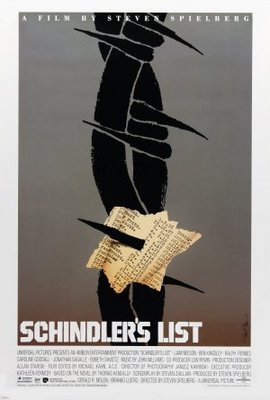 Can a film’s reputation for high quality and moral weightiness make the act of watching it a daunting experience? Actually no, 20 years later, Schindler’s List may have a high-hatted standing as an important event film that must be seen because of some kind of personal solemnity, but like Citizen Kane, it may sound like drudgery, but Schindler’s List isn’t homework. And though the subject matter is utterly disturbing and even depressing, it’s so well made, so well acted and so well crafted that for this viewer, my most recent experience watching it was completely dazzling, not to mention absorbing and even entertaining. The film also gets some undeserved contempt and jeers because Mr. Blockbuster himself, Steven Spielberg, was the director. Some see it as an attempt at self-seriousness from a guy who has prided himself on his Peter Pan complex (even making the worst Peter Pan flick of all time, Hook), but why can’t the little boy grow up and evolve? Not since The Beatles put out “Sgt. Pepper's Lonely Hearts Club Band” has an artist’s evolutionary step been so massive. Back in 1993 Schindler’s List was screened during the Oscar friendly Christmas season, when just some months earlierSpielberg had released his live-action video game Jurassic Park. One film is a shallow CGI-created attempt at cheap thrills while the other is a painstakingly rendered and emotionally devastating nightmare. Dare I say it? No matter what you think or think you’ve heard Schindler’s List is a masterpiece, one of the best films of the last 25 years.
Can a film’s reputation for high quality and moral weightiness make the act of watching it a daunting experience? Actually no, 20 years later, Schindler’s List may have a high-hatted standing as an important event film that must be seen because of some kind of personal solemnity, but like Citizen Kane, it may sound like drudgery, but Schindler’s List isn’t homework. And though the subject matter is utterly disturbing and even depressing, it’s so well made, so well acted and so well crafted that for this viewer, my most recent experience watching it was completely dazzling, not to mention absorbing and even entertaining. The film also gets some undeserved contempt and jeers because Mr. Blockbuster himself, Steven Spielberg, was the director. Some see it as an attempt at self-seriousness from a guy who has prided himself on his Peter Pan complex (even making the worst Peter Pan flick of all time, Hook), but why can’t the little boy grow up and evolve? Not since The Beatles put out “Sgt. Pepper's Lonely Hearts Club Band” has an artist’s evolutionary step been so massive. Back in 1993 Schindler’s List was screened during the Oscar friendly Christmas season, when just some months earlierSpielberg had released his live-action video game Jurassic Park. One film is a shallow CGI-created attempt at cheap thrills while the other is a painstakingly rendered and emotionally devastating nightmare. Dare I say it? No matter what you think or think you’ve heard Schindler’s List is a masterpiece, one of the best films of the last 25 years.
Though Spielberg made some truly great films:Jaws, Close Encounters of the Third Kind, E.T.: The Extra-Terrestrial, and Raiders of the Lost Ark, all might be called pop-entertainment. His first forays into more adult-themed films were adaptations of great books by Alice Walker and J.G. Ballard; first, the overrated The Color Purple and then his underrated follow-up, the very good WWII Pacific prisoner of war flick Empire of the Sun. Meanwhile, he seemed to lose his magic, producing a lot of bad children’s television while his low points as a director included Always and Hook. And then ’93 happened; he re-found the mojo with his monster hit Jurassic Park and then his ultimate grown-up flick, the holocaust epic Schindler’s List.
Child's Play
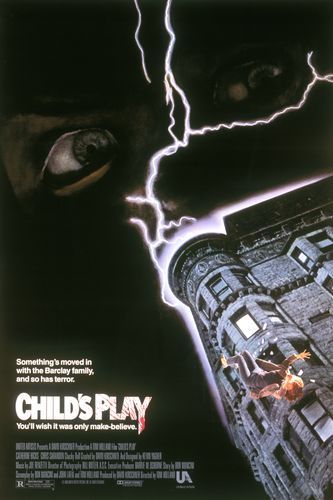 Taking a cue from the infamous Twilight Zone episode “Talking Tina,” as well as the Zuni doll segment from Trilogy Of Terror, director (and writer) Tom Holland was not only able to craft a “killer doll” movie rich with mythology that is both suspenseful & terrifying, but also arguably the best of this particular sub-genre in horror. And Child’s Play wastes no time as it opens in the middle of a police pursuit with Detective Mike Norris (Chris Sarandon) hot on the trail of Charles Lee Ray (Brad Douriff), the notorious serial killer known as the Lakeshore Strangler who has just been ditched & abandoned mid-robbery by his accomplice Eddie Caputo (Neil Giuntoli). The chase ends in a local toy store where, after a brief gun fight, Ray is mortally wounded. But before he dies, he performs a voodoo ceremony to transfer his soul into that of a Good Guy talking doll. Does the mumbo-jumbo spell actually work?
Taking a cue from the infamous Twilight Zone episode “Talking Tina,” as well as the Zuni doll segment from Trilogy Of Terror, director (and writer) Tom Holland was not only able to craft a “killer doll” movie rich with mythology that is both suspenseful & terrifying, but also arguably the best of this particular sub-genre in horror. And Child’s Play wastes no time as it opens in the middle of a police pursuit with Detective Mike Norris (Chris Sarandon) hot on the trail of Charles Lee Ray (Brad Douriff), the notorious serial killer known as the Lakeshore Strangler who has just been ditched & abandoned mid-robbery by his accomplice Eddie Caputo (Neil Giuntoli). The chase ends in a local toy store where, after a brief gun fight, Ray is mortally wounded. But before he dies, he performs a voodoo ceremony to transfer his soul into that of a Good Guy talking doll. Does the mumbo-jumbo spell actually work?
Karen Barkley (Catherine Hicks) is a recently single mother who wants nothing more than to provide for her 6-year-old son Andy. And Andy wants nothing more than to get a Good Guy doll for his birthday. When a peddler out behind the store where Karen works offers to sell her a Good Guy doll for $30 bucks over the normally excessive $100 dollar retail charge, she takes advantage so she can give her son the gift she knows he so desperately wants. All seems fine at first and Andy now has a “best friend to the end”. But then, bad things start happening around Andy.
Live Like A Cop Die Like A Man
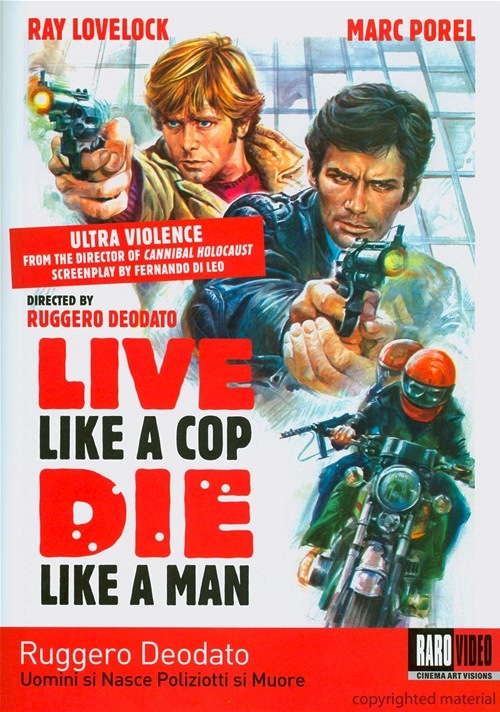 As someone who manages the “cult” section in our Hollywood location, I pride myself on both the knowledge I have of these films, as well as the immaculate organization I strive to maintain in all of the sub-sections within “cult”. (Psst… they’re alphabetized!) But of all those sub-categories, the one I know the least about is “Poliziotteschi”. Simply put, these films are a sub-genre of Italian crime and action movies that emphasize the brutal and over-the-top violence; much in the same way that “giallo” films are a series of Italian horror murder/mysteries with similar aesthetics. So I’ve always wanted to delve in and see what these “Poliziotteschi” movies were all about.
As someone who manages the “cult” section in our Hollywood location, I pride myself on both the knowledge I have of these films, as well as the immaculate organization I strive to maintain in all of the sub-sections within “cult”. (Psst… they’re alphabetized!) But of all those sub-categories, the one I know the least about is “Poliziotteschi”. Simply put, these films are a sub-genre of Italian crime and action movies that emphasize the brutal and over-the-top violence; much in the same way that “giallo” films are a series of Italian horror murder/mysteries with similar aesthetics. So I’ve always wanted to delve in and see what these “Poliziotteschi” movies were all about.
With a kick-ass title like Live Like A Cop Die Like A Man, this seemed like the ideal candidate as an introduction; after all, it carries a tremendous amount of horror pedigree with it. It was directed by Ruggero Deodato, most well known for his controversial horror classic Cannibal Holocaust. It stars Marc Porel who appeared in Lucio Fulci’s Don’t Torture A Duckling and The Psychic, as well as Ray Lovelock who also worked with Fulci in Murder Rock and appeared in the Spanish zombie flick Let Sleeping Corpses Lie. The screenplay was written by Fernando Di Leo who is well known for penning the scripts for a chunk of these “Poliziottechi” films. And then when my buddy Zane Grant (a fellow “giallo” enthusiast) started explaining to me the plot (and I use that term lightly) of this movie, I honestly couldn’t believe what he was telling me could possibly be true. I had to see this for myself. And sure enough, it’s as insane as he’d described.
The Heiress
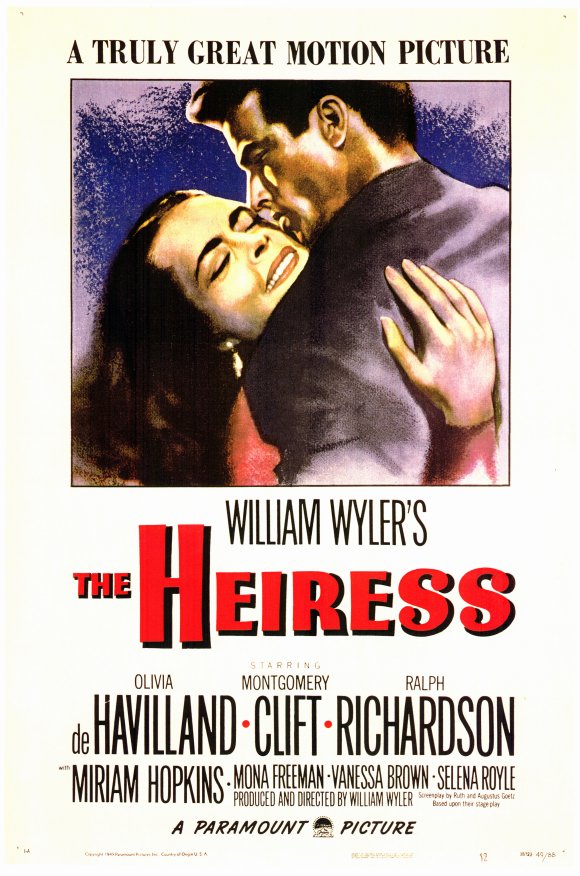 In some ways Olivia de Havilland may be one of the more underrated actresses of her generation. She wasn’t as iconic as some of her peers like Katharine Hepburn or Bette Davis and not quite as beautiful as her rival sister, actress Joan Fontaine (Suspicion); instead of sexiness de Havilland brought a righteous intelligence to her roles. She was known throughout history mostly for playing Melanie in Gone with the Wind and for her association with the dashing actor Errol Flynn in their eight films together, most notably The Adventures of Robin Hood, They Died with Their Boots On, and Captain Blood. She had a number of other relevant roles in the ‘40s including The Snake Pit, Not as a Stranger, and Hold Back the Dawn. de Havilland won two Oscars: first, for the melodrama To Each His Own and then for her most interesting performance in William Wyler’s The Heiress, based on the Henry James novel Washington Square.
In some ways Olivia de Havilland may be one of the more underrated actresses of her generation. She wasn’t as iconic as some of her peers like Katharine Hepburn or Bette Davis and not quite as beautiful as her rival sister, actress Joan Fontaine (Suspicion); instead of sexiness de Havilland brought a righteous intelligence to her roles. She was known throughout history mostly for playing Melanie in Gone with the Wind and for her association with the dashing actor Errol Flynn in their eight films together, most notably The Adventures of Robin Hood, They Died with Their Boots On, and Captain Blood. She had a number of other relevant roles in the ‘40s including The Snake Pit, Not as a Stranger, and Hold Back the Dawn. de Havilland won two Oscars: first, for the melodrama To Each His Own and then for her most interesting performance in William Wyler’s The Heiress, based on the Henry James novel Washington Square.
The late 1800s in New York City: mousy spinster Catherine Sloper (de Havilland) lives with her wise and widowed doctor father, Austin (Ralph Richardson who in real life was only 14-years-older than de Havilland), and her doting aunt, Lavinia (Miriam Hopkins). Catherine’s utterly plain and shy and unexceptional in every manner, which makes it more surprising when the handsome Morris Townsend (Montgomery Clift) shows up in town from California and immediately takes an interest in Catherine, wooing her with all his pretty-boy charms. Romanced for the first time, Catherine comes alive, becoming a giddy school girl utterly smitten with her suitor. The two lovebirds become engaged and plan to elope, but Austin doesn’t trust the rogue, knowing a playboy gold digger when he sees one; he tells Catherine he will disinherit her if she marries him. He also hurts his daughter when he coldly explains that Morris could have any young hottie in NY and why would he chose her if it’s not for the money? Proving Dad right, with the money not coming Morris doesn’t show up for the elopement and rushes back to California. Brokenhearted, Catherine realizes for the first time she really is a dullard who can only find love if she’s loaded with cash. And then to make matters worse, Austin dies and Catherine goes from a happy simpleton to a cold heiress. Years later Morris returns to try and get in on the money again, but the new self-empowered Catherine only pretends to buy into his oily trap and turns the tables on him instead, accepting a lifetime of loneliness to keep her dignity.
Silent Running
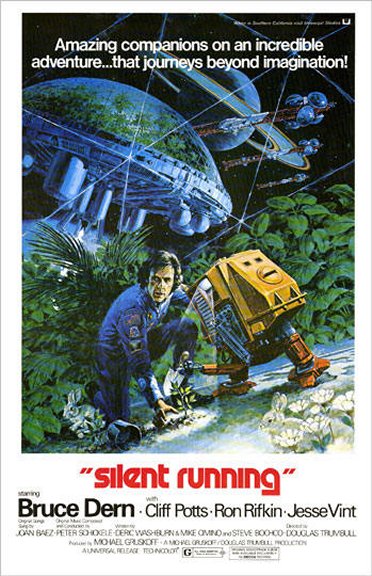 In the world of science fiction films Douglas Trumbull is quietly a hall of famer. His special photographic effects for Stanley Kubrick’s 2001: A Space Odyssey would set the standard for outer space visuals for years to come (and I, for one, still find the models more effective than CGI). As a visual effects pioneer, Trumbull would also go on to lend his expertise on films ranging from Close Encounters of the Third Kind, The Towering Inferno, Star Trek: The Motion Picture, Blade Runner, and, most recently, Tree of Life. As a director himself, he helmed two movies including Brainstorm in ’83, an interesting thriller about memory science, remembered mainly as Natalie Wood’s last film, and then, most importantly, the first film he directed: Silent Running, a sorta cerebral sci-fi environmentalist saga that has been a major influence on all the subsequent films of the genre.
In the world of science fiction films Douglas Trumbull is quietly a hall of famer. His special photographic effects for Stanley Kubrick’s 2001: A Space Odyssey would set the standard for outer space visuals for years to come (and I, for one, still find the models more effective than CGI). As a visual effects pioneer, Trumbull would also go on to lend his expertise on films ranging from Close Encounters of the Third Kind, The Towering Inferno, Star Trek: The Motion Picture, Blade Runner, and, most recently, Tree of Life. As a director himself, he helmed two movies including Brainstorm in ’83, an interesting thriller about memory science, remembered mainly as Natalie Wood’s last film, and then, most importantly, the first film he directed: Silent Running, a sorta cerebral sci-fi environmentalist saga that has been a major influence on all the subsequent films of the genre.
After all plant life has been destroyed on Earth, scientist and gardener Freeman Lowell (Bruce Dern) works aboard a giant space freighter called Valley Forge with greenhouse domes attached that hovers in space near Saturn, housing both extinct plant life and animals. The idea is that one day these space plant abodes will be able to return to Earth and repopulate its fauna. Lowell is the Adam of this wildlife Eden, aided by his three cute little robots: Huey, Dewey, and Louie, while his yahoo human shipmates (played by Ron Rifkin, Cliff Potts and Jesse Vint) get drunk and android around on their space go-carts with no sensitivity to what he is trying to cultivate.
Tootsie
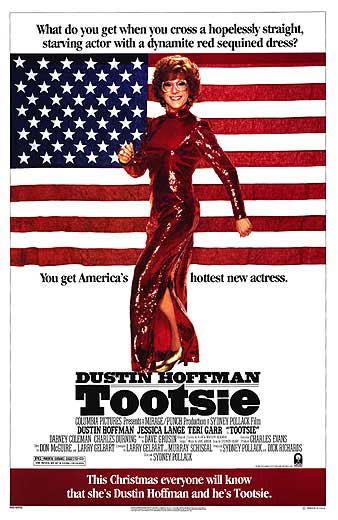 Even though it has a noticeably horrible Dave Grusin music score behind it (and even worse are the songs, giving it an icky, saccharin, early ‘80s vibe) Tootsie still manages to break conventions and has proved to be one of the best comedies of all time as well as the best film about the desperation of actors since Rosemary’s Baby. What at first can look like a gimmick, “Dustin Hoffman dresses up like a woman,” actually proves to be much more sophisticated; this isn’t a Some Like It Hot updating. With a screenplay by Murray Schisgal and Larry Gelbart (creator of M*A*S*H, the TV show and part of that group of young writers including Neil Simon, Carl Reiner, Woody Allen, and Mel Brooks who honed their skills on Your Show of Shows in the 1950s) Tootsie, like a Preston Sturges or Howard Hawks classic, is both a laugh-out-loud comedy and an insightful social examination. It may be clichéd but Hoffman’s character comes to understand being a man more from his life as an undercover woman. Fresh from the Women’s Lib era, Tootsie has a lot to say about gender roles and makes its statement cleanly.
Even though it has a noticeably horrible Dave Grusin music score behind it (and even worse are the songs, giving it an icky, saccharin, early ‘80s vibe) Tootsie still manages to break conventions and has proved to be one of the best comedies of all time as well as the best film about the desperation of actors since Rosemary’s Baby. What at first can look like a gimmick, “Dustin Hoffman dresses up like a woman,” actually proves to be much more sophisticated; this isn’t a Some Like It Hot updating. With a screenplay by Murray Schisgal and Larry Gelbart (creator of M*A*S*H, the TV show and part of that group of young writers including Neil Simon, Carl Reiner, Woody Allen, and Mel Brooks who honed their skills on Your Show of Shows in the 1950s) Tootsie, like a Preston Sturges or Howard Hawks classic, is both a laugh-out-loud comedy and an insightful social examination. It may be clichéd but Hoffman’s character comes to understand being a man more from his life as an undercover woman. Fresh from the Women’s Lib era, Tootsie has a lot to say about gender roles and makes its statement cleanly.
Struggling actor slash waiter, Michael Dorsey (Hoffman), teaches acting and coaches his friends’ auditions, but his exasperated agent (played wonderfully by director Sidney Pollack) lets him know, no one will hire him because he’s too much trouble (much like Hoffman’s own difficult reputation). After helping his needy actress friend Sandy (Teri Garr) prepare for a soap opera role, he ends up going up for it in drag and booking it, under his new stage name, Dorothy Michaels. With the help of his droll playwright roommate (an uncredited Bill Murray), keeping up his ruse as a woman becomes a fulltime job. He accidentally sleeps with Sandy, but falls in love with his soap costar Julie (Jessica Lange); she’s involved with the show’s chauvinist director (Dabney Coleman). On a weekend getaway Julie’s widower father (Charles Durning) falls for Dorothy as does her old cad costar John Van Horn (George Gaynes). Meanwhile on the set of the show Dorothy proves to be an actress who plays by her own rules, rewriting lines and following her instincts which make her an instant celebrity (I suppose once upon a time, soap operas had the ability to make their casts into names). Michael wants to put down his mask and reveal to everyone who he really is but besides ruining his now thriving career, it will complicate the relationships that he has made as Dorothy. He also begins to grasp how hard it is to be a woman in the 1980s.
The Wizard of Oz
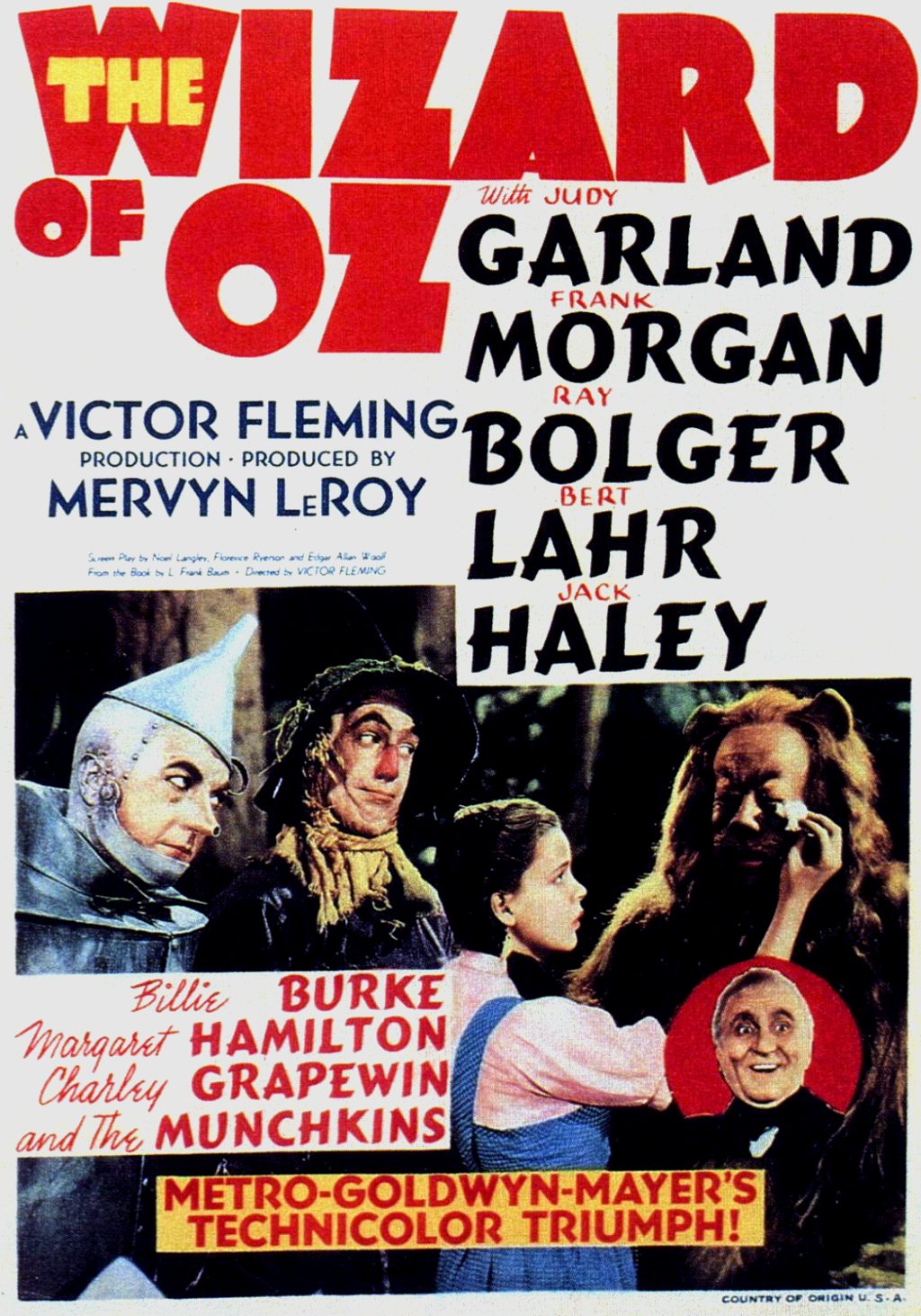 There may not be another film more ingrained in Hollywood movie culture, more iconic, or more entertaining than The Wizard of Oz. For decades its yearly broadcasts on television become a rite of passage and, like a precious family heirloom, it was passed on; each year a new generation of children was introduced to it and eventually they grew up and did the same for their kids. As adults we’ve been able to find new aspects of it to be astounded by. For kids it’s also worked as the perfect portal to make a child into a more sophisticated movie watcher—after experiencing The Wizard of Oz it’s hard for a kid to go back to watching Barney. Their brains now need newer and richer material and of course there are so many films to follow it up with.The Wizard of Oz is also notable as a massive genre bender: besides succeeding as a family film, it’s a delightful musical, a dark Depression-era period drama, and it also works as a terrifying fantasy/ horror/ adventure flick. No matter what age, who couldn’t find something to love in it?
There may not be another film more ingrained in Hollywood movie culture, more iconic, or more entertaining than The Wizard of Oz. For decades its yearly broadcasts on television become a rite of passage and, like a precious family heirloom, it was passed on; each year a new generation of children was introduced to it and eventually they grew up and did the same for their kids. As adults we’ve been able to find new aspects of it to be astounded by. For kids it’s also worked as the perfect portal to make a child into a more sophisticated movie watcher—after experiencing The Wizard of Oz it’s hard for a kid to go back to watching Barney. Their brains now need newer and richer material and of course there are so many films to follow it up with.The Wizard of Oz is also notable as a massive genre bender: besides succeeding as a family film, it’s a delightful musical, a dark Depression-era period drama, and it also works as a terrifying fantasy/ horror/ adventure flick. No matter what age, who couldn’t find something to love in it?
For folks who may be reading this from another planet, here’s the basic set-up... In the gloomy black n’ white Kansas, young Dorothy Gale (17-year-old-ish Judy Garland, playing much younger) lives on her aunt and uncle’s farm with her beloved little mutt, Toto. A mean neighbor, Miss Gulch (Margaret Hamilton), threatens to have the pooch destroyed. So Dorothy escapes the farm with Toto, and while running away she meets a traveling fortune teller named Professor Marvel (Frank Morgan) who convinces her there’s no place like home. She gets back to the farm just as a tornado sweeps in, knocking her unconscious; she and her house are swept up into the air and land in a colorful place called Oz, inhabited by an army of little people known as Munchkins. It turns out her house landed on top of a witch, killing her, and leaving her still-living green sister, the Wicked Witch of the West (again, Hamilton), irate. Dorothy would be dead meat but as informed by another witch, this one kindly and beautiful, named Glinda (Billie Burke), the magic ruby slippers she is now in possession of will protect her. The Wicked Witch leaves swearing revenge. Dorothy is eager to get back to dullsville, Kansas, so before ditching her, Glinda suggests she follow the yellow brick road which will lead her straight to the brilliant Wizard who should know how to get her home.
When We Were Kings
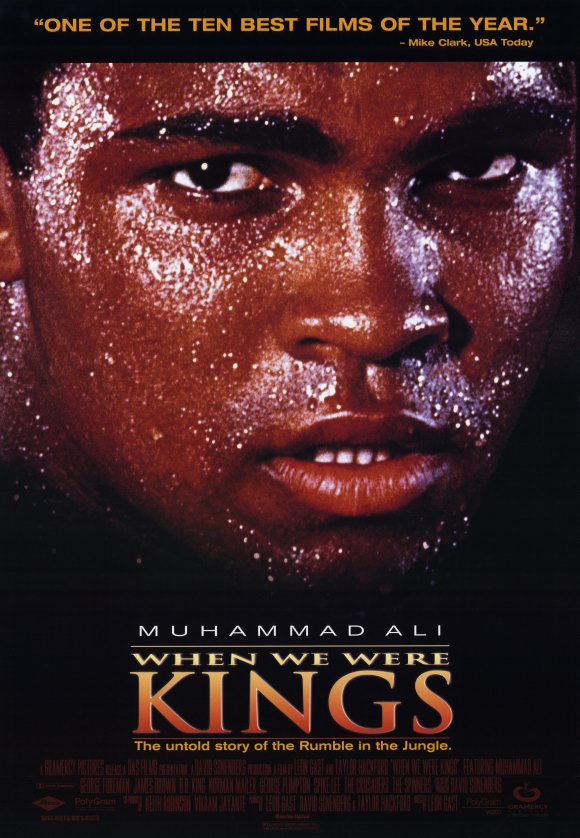 More than just a documentary about boxing or a boxer or a fight, Leon Gast’s astoundingly epic documentary When We Were Kings captures a fascinating period of history and tells the story of how a cocky young fighter named Cassius Clay became the worldwide icon known as Muhammad Ali. The biggest event in boxing history—and maybe the biggest event of the decade—was when boxing promoter Don King got the latest champ, the hard-hitting monster George Foreman, to take on the supposedly washed up 33-year-old ex-champ Ali in Zaire in ’74, in the event known as “the rumble in the jungle.”
More than just a documentary about boxing or a boxer or a fight, Leon Gast’s astoundingly epic documentary When We Were Kings captures a fascinating period of history and tells the story of how a cocky young fighter named Cassius Clay became the worldwide icon known as Muhammad Ali. The biggest event in boxing history—and maybe the biggest event of the decade—was when boxing promoter Don King got the latest champ, the hard-hitting monster George Foreman, to take on the supposedly washed up 33-year-old ex-champ Ali in Zaire in ’74, in the event known as “the rumble in the jungle.”
Ragtime
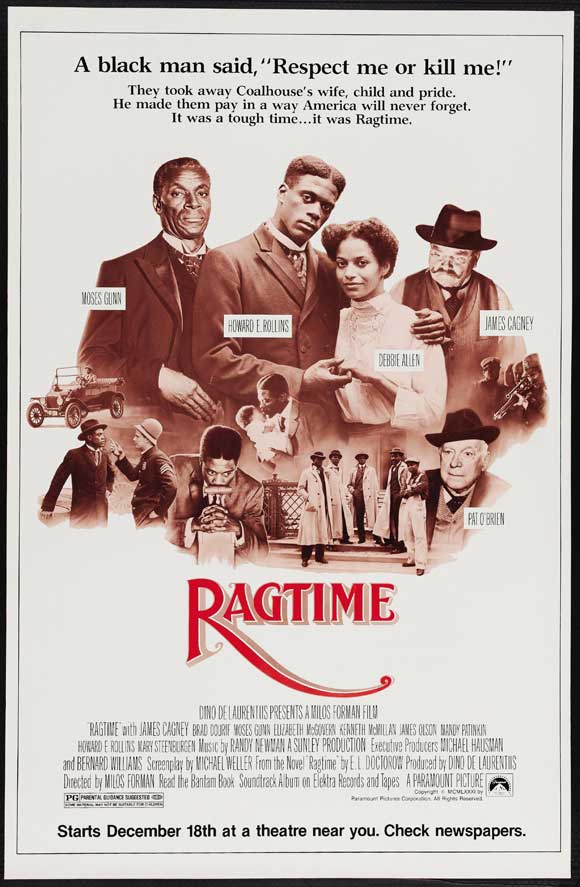 For Czech director Milos Forman, in that brief 10 year period between his two masterpieces, One Flew over the Cuckoo’s Nest and Amadeus, he took on two monumental American mini-institutions as sources. Hair, his film version of the groovy stage musical about the Age of Aquarius, is mildly memorable, while Ragtime, his big adaptation of E.L Doctorow’s hugely popular and influential novel, was largely ignored in its day; but 20-something years later it holds up and now looks like one of the most overlooked historical dramas of the decade. Ragtime is a film about the small details and how little incidents can grow and change history and people’s lives. With a fascinating cast and some interesting, ahead-of-its-time politics, Ragtime is truly an original and entertaining movie.
For Czech director Milos Forman, in that brief 10 year period between his two masterpieces, One Flew over the Cuckoo’s Nest and Amadeus, he took on two monumental American mini-institutions as sources. Hair, his film version of the groovy stage musical about the Age of Aquarius, is mildly memorable, while Ragtime, his big adaptation of E.L Doctorow’s hugely popular and influential novel, was largely ignored in its day; but 20-something years later it holds up and now looks like one of the most overlooked historical dramas of the decade. Ragtime is a film about the small details and how little incidents can grow and change history and people’s lives. With a fascinating cast and some interesting, ahead-of-its-time politics, Ragtime is truly an original and entertaining movie.
The film begins like the book: a sprawling story of scandal and trouble in the first decade of the 20th Century. It mixes real-life characters with fictional creations (similar to HBO’s Boardwalk Empire, the pulp work of James Ellroy, and countless books and films since). The famous murder trial of Harry Kendall Thaw (Robert Joy), who shot architect Stanford White (played well by overly macho writer Norman Mailer) over an affair with his wife, the showgirl Evelyn Nesbit (fresh out of Ordinary People, Elizabeth McGovern), dominates the first act. Meanwhile, a nice family just north of Manhattan in New Rochelle goes through massive changes. Mother (Mary Steenburgen) and Father (James Olson, an actor I wasn’t familiar with, who’s outstanding in this) try to keep their dignity while their Victorian values are constantly challenged. Her weird sibling, Younger Brother (Brad Dourif, less weird than usual, but still odd), works for Father at the fireworks factory and is obsessed with Evelyn, but she is too much the starlet for him. Meanwhile, Mother has taken in a black woman, Sarah (Debbie Allen), and her new baby. This is the thread plot that overtakes and dominates the story.
Kiss Meets the Phantom of the Park
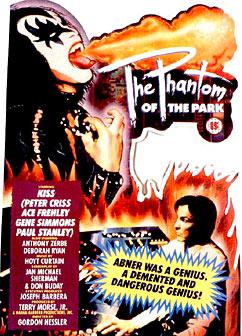 At the height of their superstardom in 1978 it was time for the Kabuki make-up sporting rock band Kiss (Gene Simmons, Paul Stanley, Peter Criss, Ace Frehley) to branch out into the movies. After all, it was the same year that The Bee Gees starred in the super dud, Sgt. Pepper’s Lonely Hearts Club Band. Instead of going the way The Beatles did 14 years earlier when they hooked up with an acclaimed young director, Richard Lester, to helm their little masterpiece A Hard Day’s Night, Kiss wanted an easier cash-in, or so the story goes. So instead of doing an edgy film to keep up with their violent, hard rockin’ persona, they hooked up with TV cartoon producers Hanna-Barbera (The Flintstones, Yogi Bear, etc.) in the hopes of selling their products to a much younger audience and ended up with a disastrous TV-movie that the band has more or less disowned. Though not as campy as The Ramones in Rock ‘n’ Roll High School or as weird as The Monkees in Head or as boring as Neil Diamond in The Jazz Singer, it is a few levels better than The Village People opus, Can’t Stop the Music. Kiss Meets The Phantom of the Park is truly one of the great oddities in the mixing of rock stars and celluloid; it can be hard to find on DVD as it’s only available in different bootleggy editions (and surprisingly a European cut is on a Kiss anthology DVD), but as a pure piece of cultural fascination and laugh-out-loud absurdity it’s worth seeking out.
At the height of their superstardom in 1978 it was time for the Kabuki make-up sporting rock band Kiss (Gene Simmons, Paul Stanley, Peter Criss, Ace Frehley) to branch out into the movies. After all, it was the same year that The Bee Gees starred in the super dud, Sgt. Pepper’s Lonely Hearts Club Band. Instead of going the way The Beatles did 14 years earlier when they hooked up with an acclaimed young director, Richard Lester, to helm their little masterpiece A Hard Day’s Night, Kiss wanted an easier cash-in, or so the story goes. So instead of doing an edgy film to keep up with their violent, hard rockin’ persona, they hooked up with TV cartoon producers Hanna-Barbera (The Flintstones, Yogi Bear, etc.) in the hopes of selling their products to a much younger audience and ended up with a disastrous TV-movie that the band has more or less disowned. Though not as campy as The Ramones in Rock ‘n’ Roll High School or as weird as The Monkees in Head or as boring as Neil Diamond in The Jazz Singer, it is a few levels better than The Village People opus, Can’t Stop the Music. Kiss Meets The Phantom of the Park is truly one of the great oddities in the mixing of rock stars and celluloid; it can be hard to find on DVD as it’s only available in different bootleggy editions (and surprisingly a European cut is on a Kiss anthology DVD), but as a pure piece of cultural fascination and laugh-out-loud absurdity it’s worth seeking out.
The opening credits include Kiss performing their mega-hit “Rock and Roll All Nite,” but then they take a breather, absent from the movie’s incredibly long-feeling first act. California’s Magic Mountain amusement park employs a brilliant inventor with a high-tech lab; unfortunately, though, the hype around Kiss performing at the park has turned Abner Devereaux (Anthony Zerbe, who played the similarly creepy Matthias in The Omega Man) into some kind of mad doctor. Doctor Abe builds lifelike cyber robots that appear all over the park, but when a pesky employee, Sam (Terry Lester fresh from TV’s Ark II), takes a break from wooing his girlfriend, Melissa (Deborah Ryan), to asks Abe a few questions the mad man turns him into some kind of robotic zombie with a mind control switch attached to his neck. The doc then has fun messing with a trio of rowdy bikers: Chopper, Slime, and Dirty Dee, before his robots attack them. Also about every 10 minutes the screen dramatically fades to black for commercial breaks.











